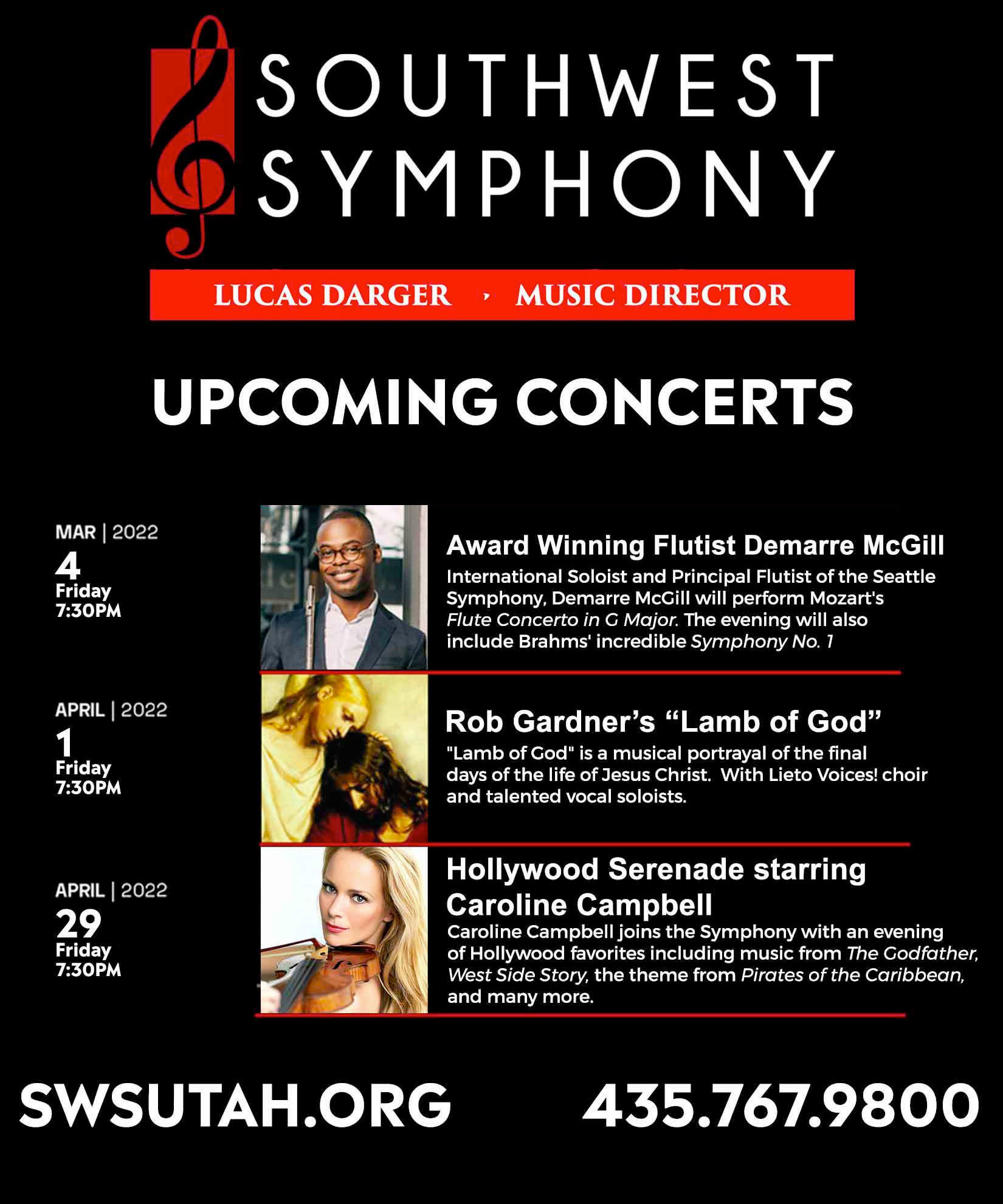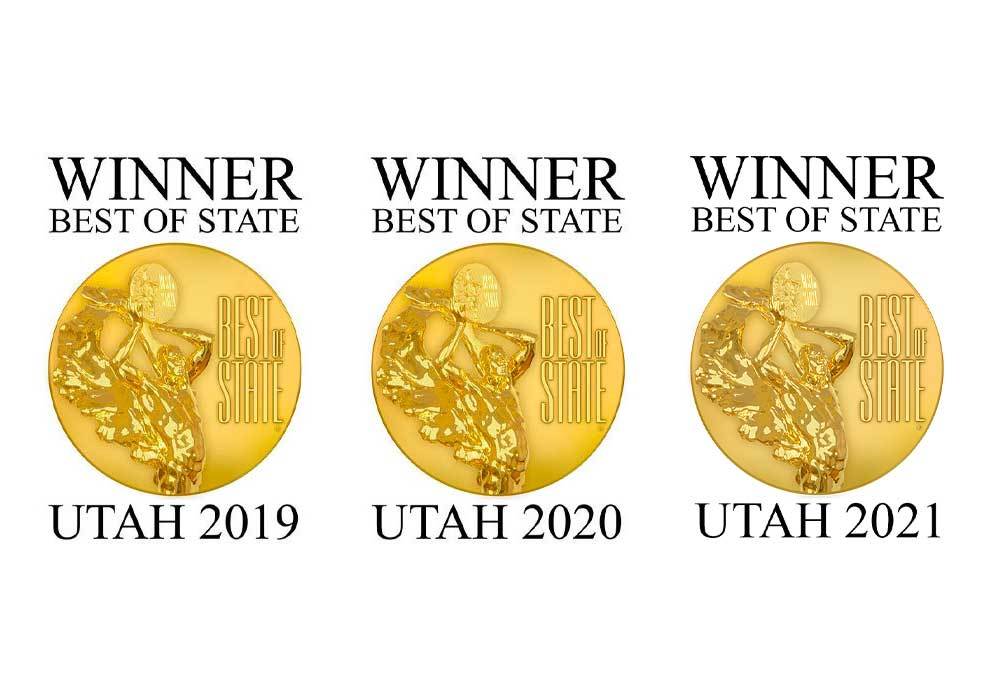Use Preferences to change the theme
Theme:

Thank you!

Follow us:
Tonight’s Program
Concertino for Xylophone & Orchestra
Southwest Symphony Competition Gold Medalist Caitlyn Rollo, Marimba
Toshiro Mayuzumi
I. Allegro vivace
II. Adagietto
III. Presto
.......
Peter and the Wolf
Geoffrey Reynolds, Narrator
Sergei Prokofiev
.......
Finlandia
Side-by-Side with the Zion Youth Symphony Orchestra
Jean Sibelius
From the Board
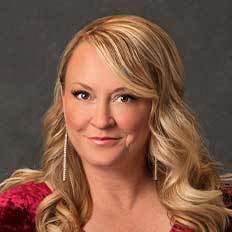
Alyce Gardner
Board Chair
Dear Friends,
We are standing on the precipice of a new age. As we have painfully learned over the past months with Covid-19, our way of life has been threatened. We have experienced grief, loss, sadness and isolation. The performing arts have been stripped from our culture excluding us from the enrichment humanity desires and needs.
Moving forward, redefining an unknown future is as difficult as living through the changing realities of today. As we stand in this moment of reassessment it’s imperative we assimilate the lessons learned. How do we confidently move forward in this global state of affairs? I suggest we unite in a spirit of gratitude. Because of Covid, I have rediscovered a profound depth of appreciation for music and what it means to my way of life. To me, it’s not an accessory but an integral part of my life which makes me whole. Music and the arts are not recyclable assets I pull off the shelf when I need an emotional impact. They are part of me and define so much of who I am.
I hope we don’t lose sight of the lessons learned, but embrace a new way of living with a deeper sense of gratitude for the beauty in the world around us. Each day is a gift. Cherish this time. Enjoy living in each joyful moment and let the music inspire you like never before.
Meet the Maestro

Lucas Darger
Now in his sixth year with the Southwest Symphony, Maestro Darger is honored to continue to work with this amazing group of musicians and be part of this community. Under his leadership the symphony has continued to take on even more difficult repertoire each year and has risen to the challenge. The orchestra performs very diverse repertoire, from the masterworks of Beethoven to the hits of Billy Joel, and in April 2021 the orchestra recorded a special for national TV with Marie Osmond.
Darger is a passionate conductor and musician and strives to achieve expressive performances that captivate and energize audiences. He began his journey with conducting when he was sixteen years old after being asked to assist with the All City Children’s Orchestra. He continued to study conducting while pursuing a degree in Violin Performance, studying with Dr. Robert Baldwin and conducting the Lincoln Youth Symphony. He went on to earn a master’s degree in orchestral conducting from the University of Iowa. There he studied with William LaRue Jones and conducted both the Philharmonic Orchestra and the UI String Orchestra while performing with Orchestra Iowa and the Dubuque Symphony Orchestra. He completed further studies with Michael Jinbo at the Pierre Monteux School for Conductors before moving to Texas, where he joined the Valley Symphony Orchestra and conducted the South Texas Youth Symphony.
Biographies
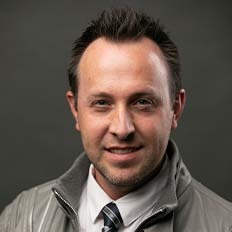
Geoffrey Reynolds
Geoffrey Reynolds is the narrator for Peter and the Wolf. He directs the premier song and dance team, Raging Red, at Dixie State University. Reynolds has an MFA in Musical Theater from The Boston Conservatory and a BFA in in Musical Theatre and Theatre Education from BYU. He has over 20 years of experience as a professional actor, director, choreographer and teacher.
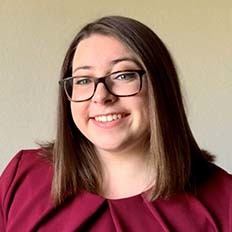
Caitlyn Rollo
Caitlyn Rollo is the Southwest Symphony’s Competition Gold Medalist. After graduating from Snow Canyon High School, Caitlyn is now pursuing a Music Education Major at DSU. She is the Percussion section leader for the DSU band.
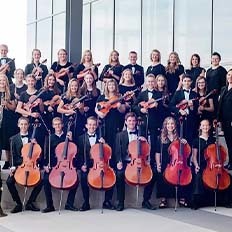
Zion Youth Symphony Orchestra
Zion Youth Symphony Orchestra is under the direction of Kirsten Candland and Ed Candland. ZYSO encourages and offers young musicians of advanced accomplishments and exceptional talent the opportunity for study, performance, and creation of music on a professional level.
Orchestra Members
Violin I
Rachel France, Concertmaster
Debbie Hafen, Assistant Concertmaster
Ahnalisse Gubler
Natalie Nelson
Amber Morris
Julie Valadez
Kimberly Warburton
Julia Monson
Violin II
Joie Whittaker, Principal
Lichelle Jones, Assistant Principal
Melanie Nielsen
Lauren Jess
Kristen Kjar
Cyndi Martin
Amy Gray
Debbie Thornton
Andrea Luikart
Camille Allton
Viola
Linda Ghidossi-DeLuca, Principal
Shay Manley, Assistant Principal
Dinah Nagel
Kevin Lasnier
Craig Beagley
April Olsen
Norman Fawson
Cello
Ka-Wai Yu, Principal
Peter Romney, Assistant Principal
Mia Taylor
Kent McDonald
Leslie Jack
Debra Vradenburg
Ann Evans
Sandy Gustaveson
Peggy Lambert
Joe Duwel
Sebastian Fraser
Bass
Deni Jones
Amy Gardner
Ed Candland
Braxton Leavitt
Harp
Jane Dastrup
Flute
Katrina Jones
Shauna Zitting
Oboe
Kendyl Johnson
Tami Stillitoe
Clarinet
Melissa Bennion
Greg Johnston
Alto Sax
Chris Flinders
Bassoon
Shanan Arslanian
Carolyn Johnston
Horn
David Lintz
David Hay
Tabitha Nygaard
Randy Bassuener
Trumpet
Jared Nicholson
Sam Dickson
LuWayne Barber
Trombone
Timothy Francis
Steve Davis
Jay Nygaard
Tuba
Brad Stucki
Percussion
David Salisbury
Grace Palfreyman
Timpani
Ro Webb
Conductor
Lucas Darger
Music Librarian
Julia Monson
Zion Youth Symphony Orchestra Members
VIOLIN 1
Megan Davidson
Ryan Downward
Marley Ham
Amelia Jones
Ivan Richardson
Natalie Roper
Tyler Wallin
VIOLIN 2
Tommy Davidson
Natalie Edie
Rachel Hansen
Lorena Hardy
Eden Smith
Charlie Tucker
Brigham Whitney
Sophie Wilkes
VIOLA
Mae Brooks
Anne Musser
Cailey Tullis
CELLO
Raeghan Bangerter
Trent Coombs
Joseph Ferguson
Caroline Hilts
Sam Hodnett
Dayson Macdonald
Nathan Mathews
BASS
Logan Brock
Mark Helske
OBOE
Paris Tracy
CLARINET
Kyle Smith
HORN
Jay Dressler
TROMBONE
Zane Larsen-Keurth
TUBA
Cameron Eggleston
PERCUSSION
Logan Hadlock
Evan Jones
Jeff Parra
Program Notes
Concertino for Xylophone (1965) Toshiro Mayuzumi, 1929-1997
Another 20th century selection on the program this evening is an example of cross-cultural influence. The Concertino for Xylophone by Toshiro Mayuzumi was composed in 1965. Mayuzumi is representative of an amazing cultural phenomenon that has taken place in East Asia. Western classical music by the masters was introduced into Japan beginning in the late 1800s. Mozart, Bach, Wagner, Beethoven, and all the other European masters became immensely popular in Japan. Japan has its own strong traditional music heritage, so it is unusual to adopt such a complicated foreign tradition so thoroughly. Japanese students begin music training at age 6 and are encouraged to begin playing European orchestral instruments at that point. 20% of the world market for Western Classical music is in Japan. In Tokyo alone, there are over 4,000 classically trained professional musicians and the city supports the largest number of professional orchestras in the world. It is only natural that such a strong affinity for European musical traditions will lead to composers and performers of world renown.
Toshiro Mayuzumi was born in the city of Yokohama in 1929. Educated in both the Western and Japanese musical traditions at the Tokyo National University of Fine Arts and Music, Mayuzumi graduated in 1951. After that, he attended the Paris Conservatorie National Superieur de Musique, where he furthered his studies with the cutting edge of the Avant-garde movement.
With Mayuzumi’s background in various musical traditions and his interest in blending traditions, he went on to compose ballet, opera, solo instrumental works, and major works for full orchestra. Additionally, you may hear his music in the many film scores he created. He was nominated for both a Golden Globe and Oscar for his score to the American movie, The Bible: In the Beginning in 1966.
The Concertino features an instrument usually reserved for color in the western tradition. The xylophone originated in Africa and Asia and was seldom featured as a solo instrument in orchestral works before the 20th Century. The wooden “keys” generate pitch by the length, are configured like a piano keyboard, struck by mallets, and have resonating tubes underneath the keys to amplify the sound. The blending of differing culture styles and periods is apparent from the very first notes.
The ensemble begins by creating a sense of tense anticipation that resolves into the main theme. Unlike some modern music, the theme is stated clearly and is easy to identify. The contemporary feel comes from the syncopated energy in the accompaniment and pronounced dissonance. The energy intensifies, growing into a restatement of the opening theme. This is followed by an angry development section. This relentless energy, always pushing forward, reminds us of techniques used in film scores to create anticipation and action. There is an abrupt break where the soloist quietly explores various thematic options in an almost improvised fashion. The exploration then evolves back the opening theme and this restatement quickly culminates a flourishing ending.
Peter and the Wolf (1936) Sergei Prokofiev, 1891-1953
Sergei Prokofiev was born in Sontsivka, Ukraine, to a scientifically trained agriculturist father and a mother who was the daughter of legal serfs, bound to one of the noble families in the region.
His mother, Maria, had devoted her life to music. She was the product of a program where children of serfs were taught theater and the arts. It was listening to his mother’s piano that gave young Sergei his first exposure to Beethoven and Chopin. An inspired Sergei wrote his first composition at age 5.
Prokofiev began to study with the Russian composer, Reinhold Gliere, who helped his young student master the fundamentals of composition. Prokofiev later attended the prestigious St. Petersburg Conservatory of Music, where he worked under Glazunov and Rimsky-Korsakov. With the death of his father in 1910, Prokofiev began to play professionally to earn his tuition, and was especially interested in the changing contemporary styles of the early 20th century. Sergei Diaghilev, the master of ballet, urged Prokofiev to focus on making “Russian” music instead of flowing with the whims and fades of contemporary styles. This led to the composition his first major ballet.
Tsarist Russia was overthrown by the communist revolution in 1917. At the time, Prokofiev had returned to St. Petersburg’s conservatory to avoid the bloodbath on the Eastern front, and it was there that he composed his Classical Symphony and Violin Concerto.
During the turmoil following the October Revolution, Prokofiev lamented that “Russia had no use of music at the moment”, and joined the large population of Russian wandering exiles. He visited the United States and European countries, composing through this time. At this point, he began to reject the eccentricities of contemporary music, which was always seeking something new and complicated, and returned to what he called the “new simplicity”.
With the Great Depression and the shrinking of budgets for music, combined with the glowing acceptance of Soviet audiences, he returned to Moscow permanently in 1936. This would mean, as contemporary Dimitri Shostakovich also found out, the State (Stalin appointees) would decide on what music and musicians would be supported by the State. Like all other aspects of Soviet life, a compelled conformity to Party norms was expected. Prokofiev managed to stay within the bounds of Party musical dictates, composing enough odes to Soviet “rightness” to be able to continue his prolific career.
Peter and the Wolf was a commissioned work by Natalya Sats, who wanted a symphony for children. Completed the year Prokofiev returned to Moscow, the piece was meant to introduce children to the individual instruments of the orchestra. The story, while Soviet approved, was so simple and engaging, it rose far above its politically correct origins. He went on a world tour with the work in the late 30’s while Sats was sent to the Gulags after her husband was executed.
The piece is for narrator and small orchestra. Prokofiev’s own notes stated, “Each character of this tale is represented by a corresponding instrument in the orchestra: the bird by a flute, the duck by an oboe, the cat by a clarinet playing staccato in a low register, the grandfather by a bassoon, the wolf by three horns, Peter by the string quartet, the shooting of the hunters by the kettle drums and bass drum.”4
Finlandia (1900) Jean Sibelius, 1865-1957
In the wars and struggles of the great European empires, Finland was always a country being fought over by stronger, belligerent neighbors. A unique and distinctive people with their own sense of fierce independence, the Finns were cursed with a Russian Empire, and later the Stalinist USSR, as their immediate neighbors.
Finnish born but Swedish by culture, Sibelius lost his father when he was three, and debts forced his mother to move into his widowed grandmother’s house. It was his uncle, Pehr, who took the place of his father and oversaw young Sibelius’s musical training. Uncle Pehr gave his nephew his first violin at age 10 and encouraged Jean to continue to study composition.
The family would summer on the coast, where Sibelius developed a deep love of nature and country. Here, he also learned piano, but ultimately returned to his first love, the violin. In his mid-teens, Sibelius furthered his violin studies with the hopes of becoming a virtuoso performer. While he did become an amazingly fine player, composition eventually captured his heart.
Sibelius began study as a lawyer, but realized his passion was music. He left his law studies and entered the Helsinki Music Institute. From there, he continued his training in Berlin and Vienna. In addition to composition, Sibelius also conducted and taught. It was during the late 1890’s that Tsar Nicholas II began to restrict Finnish rights and speech. This led Sibelius to begin compositions to promote Finnish culture and history in the face of Russian oppression. Tonight’s piece represents an example of this nationalistic statement.
Finlandia, which premiered in Helsinki in 1900, is Sibelius’s most well-known piece. In the early years, Finlandia went by many different titles to avoid Russian censorship, but its popularity grew to become the epitome of Finnish national spirit. The chorale portion of the piece was reworked into a stand-alone hymn in 1941 during the horrible “Winter War”. In a “devils deal” Stalinist Russia worked out an agreement with Hitler that allowed the Red Army to invade and take Finland. This invasion failed but at great cost to the Finns. The hymn tune, which now appears in many Christian hymnals, became an important statement of Finnish resistance and unity during that dreadful time.
By date, the piece is technically 20thCentury, but its grand Romantic era roots are apparent from the first chord.The opening has the brass choir boldly proclaiming a majestic and heroic theme. This is then contrasted with the woodwind choir responding with a quietly, melodic chorale of its own. The strings pick up this chorale idea, moving into a fuller development of the growing musical ideas. Woodwinds and brass join the strings as the mood suddenly changes. The opening statement returns, though much faster, with an energetic evolution into a stirring heroic section.
The excitement breaks and abruptly moves into the hymn portion. Many of you may recognize the melody, even if you haven’t heard the piece before. The Finnish words talk of a new day banishing the terrors of the winter darkness. A new day will dawn, and Finland will rise from the ashes a new and stronger country.The Hymn ends with the return of the heroic orchestral theme that takes us to a jubilant finale
— Program Notes by Greg Johnston











